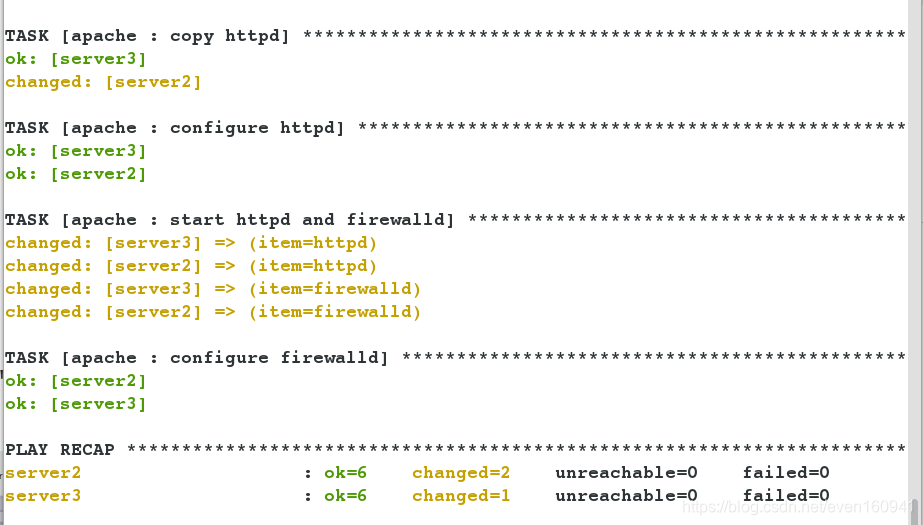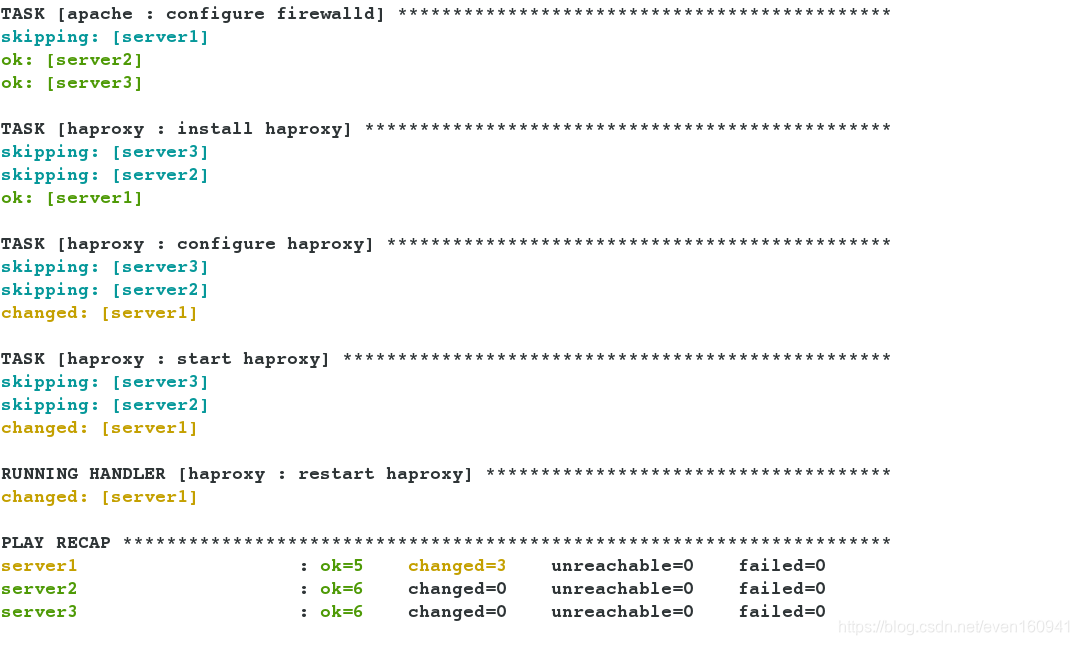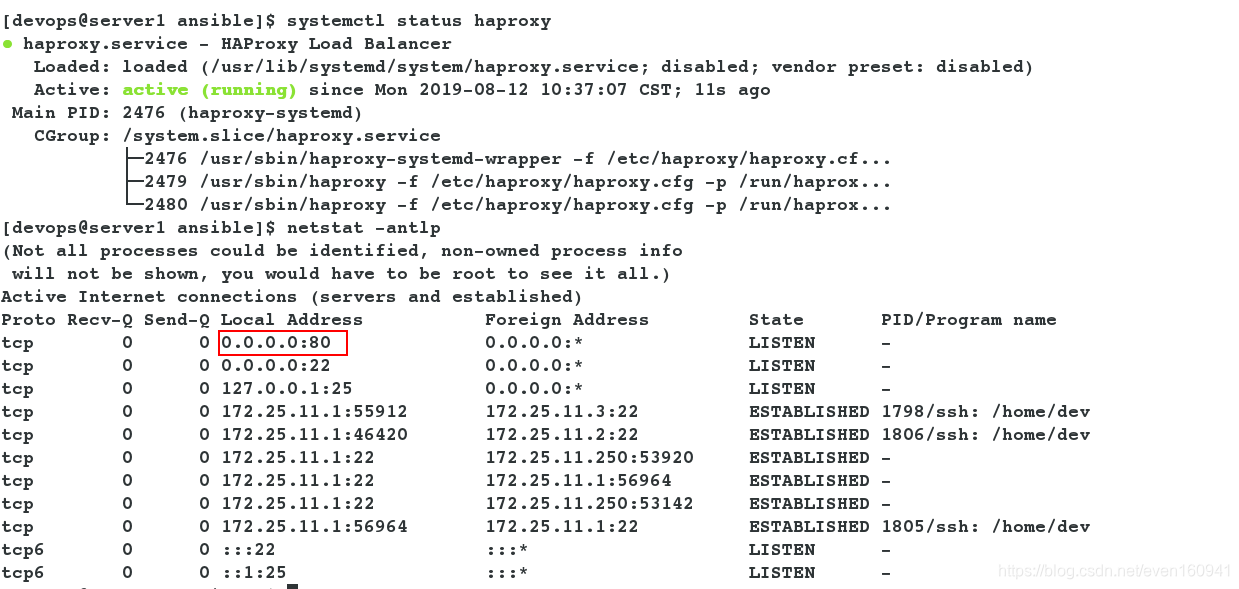文章目录
Ansible roles简介
- Ansible roles是为了层次化、结构化地组织Playbook。
- roles就是通过分别将变量、文件、任务、模块及处理器放置于单独的目录中,并可以便捷地include它们。
- roles一般用于基于主机构建服务的场景中,在企业复杂业务场景中应用的频率很高。
- 以特定的层级目录结构进行组织的tasks、variables、handlers、templates、files等;相当于函数的调用把各个功能切割成片段来执行。
roles目录结构
role_name:定义的role名字
- files:存放copy或script等模块调用的函数
- tasks:定义各种task,要有main.yml,其他文件include包含调用
- handlers:定义各种handlers,要有main.yml,其他文件include包含调用
- vars:定义variables,要有main.yml,其他文件include包含调用
- templates:存储由template模块调用的模板文本
- meta:定义当前角色的特殊设定及其依赖关系,要有main.yml的文件
- defaults:要有main.yml的文件,用于设定默认变量
创建roles
- role存放的路径在配置文件
/etc/ansible/ansible.cfg中定义:roles_path = /etc/ansible/roles
举例
利用roles给主机安装并开启httpd服务,并将httpd加入防火墙列表中
- 切换到普通用户devops,在用户家目录下的ansible目录下新建目录roles。
su - devops
cd ansible
mkdir roles
- 编辑ansible.cfg文件,添加roles的路径
[devops@server1 ansible]$ vim ansible.cfg
[defaults]
inventory = ./inventory
roles_path = ./roles #当前目录下
[privilege_escalation]
become=True
become_method=sudo
become_user=root
become_ask_pass=False
- 创建一个apache模版
[devops@server1 roles]$ ansible-galaxy init apache
[devops@server1 roles]$ cd apache/
[devops@server1 apache]$ ls
defaults files handlers meta README.md tasks templates tests vars
[devops@server1 apache]$ rm -fr README.md tests #可以删除这两个文件目录
[devops@server1 ansible]$ pwd
/home/devops/ansible
[devops@server1 ansible]$ ansible-galaxy list #列出所有的galaxy

- 编辑几个main.yml文件,即将之前的playbook.yml文件中的内容进行拆分。
- 复制模版文件到apache的模版目录下
[devops@server1 apache]$ cp ~/ansible/templates/httpd.conf.j2 templates/
[devops@server1 apache]$ cd templates/
[devops@server1 templates]$ ls
httpd.conf.j2
- 编辑任务tasks的main.yml文件
[devops@server1 apache]$ \vi tasks/main.yml
---
- name: install httpd
yum:
name: httpd
state: present
- name: copy httpd
copy:
content: "{{ ansible_facts['hostname'] }}"
dest: /var/www/html/index.html
- name: configure httpd
template:
src: httpd.conf.j2 #注意修改路径
dest: /etc/httpd/conf/httpd.conf
owner: root
group: root
mode: 644
notify: restart httpd
- name: start httpd and firewalld
service:
name: "{{ item }}"
state: started
loop:
- httpd
- firewalld
- name: configure firewalld
firewalld:
service: http
permanent: yes
immediate: yes
state: enabled
- 编辑触发器handles的main.yml文件
[devops@server1 apache]$ \vi handlers/main.yml
---
- name: restart httpd
service:
name: httpd
state: restarted
- 编辑变量的main.yml文件
[devops@server1 ansible]$ vim roles/apache/vars/main.yml
---
http_host: "{{ ansible_facts['default_ipv4']['address'] }}"
http_port: 80
- 新建apache.yml文件
[devops@server1 ansible]$ vim apache.yml
---
- hosts: webserver
roles:
- apache
- 修改inventory文件为如下。
[devops@server1 ansible]$ vim inventory
[test]
server2
[prod]
server3
server4
[webserver:children]
test
prod
- 进行检测并执行
[devops@server1 ansible]$ ansible-playbook apache.yml -C #只检测,不做任何修改
[devops@server1 ansible]$ ansible-playbook apache.yml

haproxy的部署(实现负载均衡)
- 创建一个haproxy模版
[devops@server1 roles]$ ansible-galaxy init haproxy
- haproxy was created successfully
[devops@server1 roles]$ ls
apache haproxy
- 编辑触发器的main.yml文件
[devops@server1 haproxy]$ \vi handlers/main.yml
---
- name: restart haproxy
service:
name: haproxy
state: restarted
- 复制模版文件到haproxy的模版目录下
[devops@server1 haproxy]$ cp ~/ansible/templates/haproxy.cfg.j2 templates/
[devops@server1 haproxy]$ cd templates/
[devops@server1 templates]$ ls
haproxy.cfg.j2
- 编辑任务的main.yml文件
[devops@server1 haproxy]$ \vi tasks/main.ym
---
- name: install haproxy
yum:
name: haproxy
state: present
- name: configure haproxy
template:
src: haproxy.cfg.j2 #注意修改路径
dest: /etc/haproxy/haproxy.cfg
notify: restart haproxy
- name: start haproxy
service:
name: haproxy
state: started
- 在刚才apache.yml文件的基础上进行编辑,增加判断条件。
---
- hosts: all
tasks:
- import_role:
name: apache
when: ansible_hostname in groups['webserver']
- import_role:
name: haproxy
when: ansible_hostname in groups['lb']
- 编辑inventory文件
[devops@server1 ansible]$ vim inventory
[lb]
server1 #写localhost则会提示skipping
[test]
server2
[prod]
server3
[webserver:children]
test
prod
- 执行:
[devops@server1 ansible]$ ansible-playbook apache.yml

- 执行成功后查看haproxy服务状态以及端口(我们模版文件中修改端口为80)。
[devops@server1 ansible]$ systemctl status haproxy
[devops@server1 ansible]$ netstat -antlp

keepalive+haproxy高可用的实现
在博客https://blog.youkuaiyun.com/even160941/article/details/99128262中。





 本文详细介绍Ansible Roles的使用,包括其目录结构、创建方法及如何通过Roles安装、配置httpd和haproxy服务,实现负载均衡,同时展示了keepalive与haproxy结合实现高可用性的方法。
本文详细介绍Ansible Roles的使用,包括其目录结构、创建方法及如何通过Roles安装、配置httpd和haproxy服务,实现负载均衡,同时展示了keepalive与haproxy结合实现高可用性的方法。
















 1558
1558

 被折叠的 条评论
为什么被折叠?
被折叠的 条评论
为什么被折叠?








